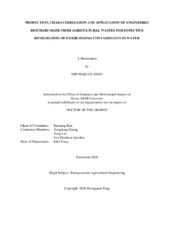| dc.description.abstract | Biochar (BC) was produced from oxygen-limited pyrolysis of biomass. Bermudagrass (BG), as
one of the most productive forage grasses, is widely planted in U.S. with annual dry matter yield
of 6-10 tons per acre. The main objectives of this dissertation are to valorize BG to activated BCs
by pyrolysis and activation for solving problems of water pollution by emerging contaminants
(ECs), which are harmful for ecosystem and human health.
After NaOH and FeCl₃ activations, activated BCs showed high surface areas of 1992 and 1035
m²/g and high adsorption capacity of 425 and 265 mg/g BC for antibiotic sulfamethoxazole (SMX), respectively, which were higher than various BCs and activated carbons. Activated BCs were confirmed to adsorb SMX through π-π EDA, hydrophobic, and hydrogen bond interactions with intraparticle diffusion limitation. NaOH desorption and thermal oxidation could effectively
regenerate SMX-spent activated BCs. In addition, FeCl₃ activated BC without acid washing could remove SMX via simultaneous adsorption and heterogeneous Fenton oxidation.
FeCl₃ activated BC was also applied for adsorption of microcystin-LR (MC-LR) and showed high adsorption capacity compared to other adsorbents. The thermal regeneration showed excellent regeneration efficiency (above 99%) of MC-LR spent FA-BC. In addition, persulfate oxidation showed better performance than Fenton oxidation to regenerate the MC-LR spent FA-BC. Both diffusion and desorption of MC-LR from FeCl₃ activated BC controlled the MC-LR oxidation during the regeneration of MC-LR spent FeCl₃ activated BC by persulfate oxidation.
Besides the removal of SMX and MC-LR via the biochar, additional works were conducted to
investigate effects of mechanical refining (MR) and BC addition on the performance of anaerobic digestion (AD) of diary manure. Biogas and methane yields from AD of dairy manure were significantly increased after MR pretreatment, due to the increase of manure solubilization,
reduction of particle size, and achievement of external fibrillation and internal delamination of
fibers in manure. The addition of alfalfa-derived BC lowered the lag phase and CO₂ content of
biogas while increasing the COD removal efficiency in the AD of dairy manure. Moreover, the
alfalfa-derived BC also resulted in the decrease of total VFAs and acetic acid concentrations. | en |


